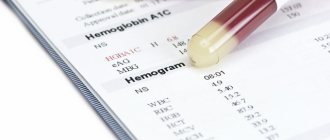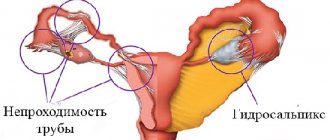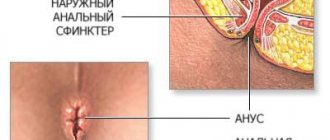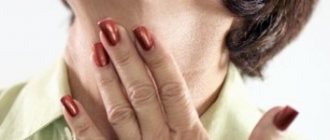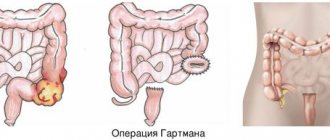Detailed description of the study
Bilirubin is a reddish-yellow pigment formed from hemoglobin. Total bilirubin is a combination of direct and indirect fractions of this pigment.
Indirect - unbound, free - bilirubin is formed from destroyed red blood cells. It is poorly soluble in water and is toxic to the body, especially when its permissible concentration in serum is exceeded. Normally, indirect bilirubin joins albumin - serum proteins - in the blood and is transported to the liver, where it is converted into direct (bound, non-free). This process is associated with a conjugation reaction - a molecule of glucuronic acid is added to free bilirubin.
The direct fraction of bilirubin is soluble in water and is not toxic to the body. Direct bilirubin enters the lumen of the small intestine along with bile, where it is divided into two parts. The first part of the pigment is absorbed into the blood and excreted from the body along with urine in the form of urobilin pigment. The second part, during biochemical reactions under the influence of enzymes of the intestinal microbiota, is converted into the pigment stercobilin, which is excreted along with feces.
Many diseases are characterized by a syndrome of increased total bilirubin in the blood, or hyperbilirubinemia. This condition is potentially dangerous due to the fact that bilirubin is toxic to the organs of the central nervous system: the brain and spinal cord.
The main clinical symptom of a pronounced increase in the concentration of bilirubin in the blood is jaundice. It is characterized by skin changes from lemon yellow, orange yellow to greenish. Jaundice is a nonspecific syndrome; its development can be caused by many diseases. In clinical practice, there are three types of jaundice:
- Hemolytic, or suprahepatic;
- Parenchymal, or hepatic;
- Mechanical, or subhepatic.
Prehepatic jaundice develops against the background of hemolysis - destruction - of red blood cells, which leads to the release of a large volume of indirect bilirubin into the bloodstream.
Hepatic jaundice is associated directly with damage to liver cells. This type of jaundice occurs with hepatitis of various origins: viral, autoimmune, medicinal, toxic, etc.
Subhepatic jaundice is associated with a violation of the outflow of bile from the liver along the bile ducts. This variant of jaundice is associated with cholelithiasis and pathologies of the pancreas, including tumors. This type of jaundice usually requires surgery.
The best biological material for determining the concentration of total bilirubin is venous blood. This study reveals the amount of pigment in capillary blood. It may be relevant for diagnosing hyperbilirubinemia in newborns (up to 1 month of life), as well as in children under 7 years of age.
Elevated serum bilirubin levels may occur as part of physiological jaundice. It occurs in most babies in the first week of life. The origin of physiological jaundice is based on the characteristics of bilirubin metabolism in newborns. However, an increase in bilirubin concentration during this period can also be a manifestation of a disease, such as hemolytic disease of the newborn (HDN). This pathology is characterized by the destruction of the baby's red blood cells, associated with the reaction of immunological intolerance to the red blood cells of the mother and child during pregnancy.
Other indications for testing bilirubin in capillary blood include:
- Large area burns;
- Small/hard-to-reach veins;
- Excessive obesity;
- Proven tendency to thrombus formation in venous vessels.
In the absence of the above indications, it is strongly recommended to study the concentration of this pigment in venous blood. In combination with the analysis of total bilirubin, it is recommended to take bilirubin fractions, liver enzymes (ALT and AST), a complete blood count and compare the results with clinical symptoms.
Generally accepted norms of indicators
The acceptable level of bilirubin concentration for each age is different. The highest concentration of the substance in the blood is observed in newborns, in the initial stages of life, up to 200 µmol/l, this is due to the period of adaptation of the newborn’s gastrointestinal tract to the digestion of mother’s milk. The acceptable level of bilirubin concentration for each age will be different. The highest concentration of the substance in the blood is observed in newborn children, in the initial stages of life. In one-year-old children and children under 13 years of age, a satisfactory indicator of the concentration of indirect pigment is considered to be up to 20.3 µmol/l, for direct pigment up to 5.2 µmol/l.
The degree of concentration of the substance for adults should not cause concern if the survey analysis shows a level of up to 19.9 µmol/l for indirect, and 4.9 µmol/l for direct bilirubin, since such measurements are satisfactory for people of the adult age category.
References
- Goncharik, T.A. Differential diagnosis of jaundice. : educational method. allowance. - Minsk: BSMU, 2009. - 24 p.
- Severin, E.S., Aleynikova, T.L., Osipov, E.V. and others. Biological chemistry. - M.: Medical Information Agency LLC, 2008. - 364 p.
- Dolgov, V.V., Menshikov, V.V. Clinical laboratory diagnostics. National Leadership, Volume 1, 2012. - pp. 196-198.
- Lifshits, V.M., Sidelnikova, V.I. Medical laboratory tests. - M.: Triad X, 2007. - P. 91-94.
Diagnostics and tests
To determine what is causing the increase in bilirubin, you need to undergo examination by a specialist. After a visual examination (checking the color of the skin, whites of the eyes, plaque on the tongue) and palpation of the abdominal cavity, the doctor prescribes laboratory diagnostics:
- BAC for the content of direct or indirect bilirubin;
- Aspartate aminotransferase and alanine aminotransferase assay;
- Ultrasound examination of the liver.
Blood sampling may be prescribed for a detailed clinical analysis.
Correct therapy can be prescribed only with an accurate diagnosis. In some cases, the help of an infectious disease specialist and gastroenterologist is required.
Our channels
- Telegram research
- Telegram chat
Sources
[1] T. Maruhashi, Y. Kihara, Y. Higashi, Bilirubin and endothelial function, J. Atheroscler. Thromb. 26 (2019) 688–696. doi:10.5551/jat.RV17035. [2] M. Pawlak, P. Lefebvre, B. Staels, Molecular mechanism of PPARα action and its impact on lipid metabolism, inflammation and fibrosis in non-alcoholic fatty liver disease, J. Hepatol. 62 (2015) 720–733. doi:10.1016/j.jhep.2014.10.039. [3] TD Hinds, DE Stec, Bilirubin Safeguards Cardiorenal and Metabolic Diseases: a Protective Role in Health, Curr. Hypertens. Rep. 21 (2019). doi:10.1007/s11906-019-0994-z. [4] H. L. Liston, J. S. Markowitz, C. L. DeVane, Drug glucuronidation in clinical psychopharmacology, J. Clin. Psychopharmacol. 21 (2001) 500–515. doi:10.1097/00004714-200110000-00008. [5] T. Yanagita, S. Y. Han, Y. Hu, K. Nagao, H. Kitajima, S. Murakami, Taurine reduces the secretion of apolipoprotein B100 and lipids in HepG2 cells, Lipids Health Dis. 7 (2008) 1–6. doi:10.1186/1476-511X-7-38.
Indications for the study
A blood test for direct bilirubin is carried out during the diagnosis of liver pathologies. Its results are required to confirm diseases of the bile ducts, hepatitis, and hereditary liver diseases. The test is mandatory if there are characteristic symptoms of liver problems (jaundice, pain in the right hypochondrium, etc.). Its results are interpreted in conjunction with data from other studies. In most cases, a comprehensive examination is required for accurate diagnosis and selection of an effective treatment method.
Direct bilirubin: norm and pathology
Reference values
are the same for patients of both sexes and all ages. A separate norm has been established only for newborns. Normal indicators should be in the range of 0-8.6 µmol/liter. When interpreting the results, the patient’s medical history and data from other tests are taken into account.
Increasing performance
may indicate a violation of the outflow of bile for various reasons, genetic pathologies, liver pathologies. It must be taken into account that the cause of an increase in bilirubin levels can be prolonged fasting, eating large amounts of fatty foods, or taking many medications (for example, antibacterial and antifungal agents, antidepressants).
Increased total bilirubin - reasons
An increase in total bilirubin in adults leads to:
- Primary biliary cirrhosis;
- Gallstone disease and other conditions with impaired bile flow;
- Parasitic diseases;
- Liver tumors;
- Any type of hepatitis (viral, drug-induced, autoimmune, etc.);
- Intrahepatic cholestasis;
- Jaundice of pregnancy;
- Accelerated breakdown of red blood cells;
- Impaired production of enzymes in the liver that convert indirect bilirubin into direct bilirubin.
What the doctor sees on an ultrasound of the liver Ultrasound is the most popular diagnostic method when the patient complains of discomfort in the right side, nausea, weakness and general loss of strength.
Lifext application why, what are the prospects
We have made an application in which we introduce all the methods of life extension. An early version has been released right now, where monitoring and individual analysis evaluation works.
General norms and Lifext norms are assessed.
The application is multilingual - currently English + Russian.
Analysis is stored securely in the Google cloud. It immediately shows that the analysis falls within the general norms and norms of Lifext, taking into account gender and age. In the next version it will be possible to add any tests (not only from the list) + reminders when they need to be taken.
Early subscription made - 120 rubles. per month (approximately $1.9, the price may change when the course changes). When introducing cool features, the subscription will be more expensive, but for early users the price will remain the same forever. Please consider this early subscription as something like crowdfunding, since writing an application, conducting research and other activities becomes impossible only on enthusiasm.
There are still glitches and bugs, but we are constantly improving everything, we ask for your understanding 
Additionally
“Hepatoprotectors” are substances that can perform or facilitate the detoxification function, used for liver and other failures, as well as in cases of poisoning. This list is not a panacea, but, according to the author, when taken together with many drugs that are unpleasant for the liver (for example, non-steroidal anti-inflammatory drugs), it can minimize the negative consequences for the body.
- Ursodeoxycholic acid is an epimer of chenodeoxycholic acid. A non-toxic component of bile, it facilitates the digestion process. Ursosan enhances lipase activity, has a hypoglycemic effect, and enhances gastric and pancreatic secretion. Has an immunomodulatory effect. Reduces cholesterol levels in bile. Helps maintain the normal condition of people, for example, with Gilbert's syndrome, hereditary liver pathology (familial non-hemolytic jaundice)
- Acetylcysteine is a precursor to glutathione, which in turn is involved in neutralizing toxins. The antioxidant effect of acetylcysteine/glutathione is based on the ability of thiol groups –SH to bind to oxidative radicals [4].
- Taurine is an “angioprotector” and helps normalize vascular function [5]. It also binds to bile acids, providing a weak hepatoprotective effect.
Story
In 1847, the German scientist Rudolf Virchow and his colleagues separated bilirubin crystals from blood taken from a hematoma. More than a century later, Irving M. London and collaborators at Columbia University demonstrated that heme was indeed its source.
Jaundice is especially common in newborns and is not always destructive. The first mentions of it probably date back to the beginning of the 18th century. German pathologist Johannes Orth published his results in 1875 after autopsying a child who died of jaundice. The question was how to make the correct diagnosis based on more than just skin color.
At the beginning of the 20th century, while working on his dissertation, gynecologist and obstetrician Gustav Hazlehurst discovered a method for detecting bile dye in urine and blood. The blood serum was mixed with alcohol and centrifuged, causing the protein to precipitate. An indicator containing a diazo group (RC=N+=N−) was added to the turbid supernatant liquid. In the presence of bile dye, the liquid turned purple. After this step, more alcohol was added in a certain amount and the fatty acids dissolved, the liquid became transparent, if the purple color was more saturated than that of the comparison sample, this meant that the bilirubin level was higher than normal. In this case, by adding alcohol gradually, it was possible to determine how much bilirubin in the serum exceeded the norm.
Treatment of elevated bilirubin
To normalize the level of bilirubin in the blood, it is necessary to eliminate the underlying disease. Your doctor may prescribe the following treatments:
- infusion therapy, during which saline solutions and glucose are introduced into the patient’s body;
- taking medications, including phenobarbital, if we are talking about the treatment of Gilbert's syndrome, and hepaprotectors - in the case when the cause of the inflammatory process is liver damage;
- phototherapy, which involves irradiating the body with special lamps;
- change in diet.
When it comes to treating hepatitis, it is aimed at eliminating the causative virus.
